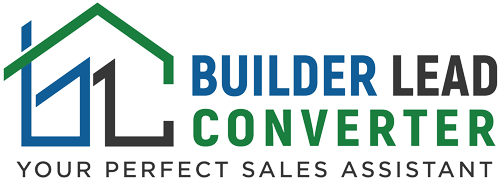Question: Why do some new home & remodeling leads choose certain builders and don’t give others the time of day?
In the second part of the multi-part series called, Why Builders Lose Sales, we look at what attracts high-quality leads to builders.
By answering the 3 questions every one of your leads has, you’ll start attracting high-quality leads to your company which allows you to start picking and choosing your clients and jobs.
Read/Watch/Listen to the full episode to learn and understand your customers’ buying habits and position yourself for success.
Builder Lead Converter ATTRACTS, CAPTURES & CONVERTS high-quality leads for builders so they can pick & choose their clients & jobs. Find out how at https://www.builderleadconverter.com
Transcript:
Rick: Today on Conversations That Convert, we are talking about why builders lose sales and what they can do about it. And today’s topic is attracting leads. Let’s get started.
Welcome to Conversations That Convert. Every week, we’ll spend about 10 to 15 minutes tackling relevant lead generation, marketing, and sales topics for remodelers, home improvement companies, and home builders. Conversations. That Convert is brought to you by Builder lead Converter, your perfect sales assistant. And now here’s Rick and Daiana.
Rick: Welcome to Conversations That Convert, convert everyone. Welcome, Daiana. How are you today?
Daiana: Hi, I am very well. Thank you and welcome everybody. And how are you today, Rick?
Rick: Well as I mentioned before, we are in the middle of a blizzard right now, but pretty to look at, but not pretty to be out in. So, today is an indoor-looking-outside day and we will dream about those warmer days, of tomorrow.
Daiana: Beautiful.
Rick: Yeah, with that being said, what, what, what better time than to record an episode of Conversations That Convert? So what are we talking about today, Daiana?
Daiana: Today it’s part two, why do Builders Lose Sales to competitors, and what they can do about it? So how do we attract leads?
Rick: Exactly. Yeah. Last week we talked about marketing and this week we’re moving on to attracting leads. So we’ll be talking about the entire sales funnel from just attracting high-quality leads to capturing, converting, and then ultimately selling them on your services, your homes, or your remodeling services.
So this is all, a series called Why Builders Lose Sales? We’re just going back and, and looking at some of the specific reasons why a client acquisition pipeline will break down. And it’s good introspectively to look at this. We have been doing this for a very long time. We’re now in our 13th year of doing this.
So we’ve studied all this and are bringing you what we find are probably the biggest Impediments to a sale. Sometimes, we blame everything on the salesperson. Sometimes we bring blame, everything on the marketing department. Sometimes we blame everything on the advertising for the leads.
Oftentimes it’s a combination of all three. So we will be talking about all three last week. If you missed it, you can look at marketing. This week is all about attracting leads. So I have a question for you, Daiana. Are you ready?
Daiana: Yes, I can assume. Or how can I blame others?
Rick: Well, that’s, that’s a good guess, but that is not the question. The question is, do new homes and remodeling leads shop by process of inclusion where they’re trying to add to their list of builders, to contemplate? Or do they shop by process of exclusion where they’re trying to cross you off their list?
Daiana: So how I do it, I include everyone on the list and I, and then I exclude every, all of them. So I think exclusion, that’s the.
Rick: Ding, ding, ding. You win the prize. Congratulations.
Daiana: Yey. Thank you.
Rick: That is how, that is how people shop, right? Not just, for our home builders and remodelers, but really anything. We’re trying to look at all of our options and then we then will cross people off. We create a shortlist, a long list to a shortlist, and those are the builders that we will reach out to.
So in this phase, when we’re talking about attracting leads, if they do not find what they are looking for, what they are attracted to, they will cross us off the list. So this is what I call an opportunity leak. Oftentimes it’s not the way that you said something wrong in the sales process.
You didn’t even get a chance to talk to ’em at this, this point in time. So what we have to understand is what are the questions that every lead is asking, and then we need to look at, okay, how can we best answer them? If we’re gonna attract somebody to us, we have to have the answers they’re looking for.
Well, in order to have the answers, they’re looking for. We have to know the questions they are asking. So the queue three questions are as, as follows, what will my project look like? So again, yeah, we can’t the product exactly, we can’t visualize this. So whether it’s a remodeling, I’m trying to visualize how will my home look differently. I’m trying to visualize my new home. I’m looking at maybe a one-dimensional floor plan. I really can’t visualize it. So that’s really the first and foremost question.
The next question is, how much will it cost, the price? And then finally, where can I build, my new home? Or do you work in my community or, or service area? That’s the place that’s specifically for remodeling or, or specialty remodeling. Excuse me. So product, place and price, product, price, and place.
And if you, if you’ve studied marketing, you know, there’s five Ps, those are three of the five Ps. And so yeah, we need to supply the answer to those leads, and that what’s, what will attract them through to our, our website or our, our online platforms such as social media as well, ads, or another one.
And, what happens here is this, is that we will answer these questions through visual content that will attract them to you. So visual content is not written. So if you’re thinking you are going to write out your great process for designing and building a custom home or a remodeling project, that is not what they’re looking for.
They want visual content. Visual content creates an emotional connection where they want to know more, they want to take the next step, and the next step, of course, is going to be opting in or creating a permission-based relationship where they give you their contact information in exchange for something more. We’ll talk about that in our next episode. So what do you think so far, Daiana, about those three questions?
Daiana: Well, it sounds like a great structure to, create your content too. Pay attention to the product price and place and, you have everything you need to inform and educate your client about your offer, right?
Rick: Yeah. Really good point. As far as your thinking of a content plan, we talked about content last week, and there are three types of content, so expert-branded, and user-generated content. This is really all part of your content plan.
Daiana: Yeah.
Rick: If you’re creating content and you’re gonna put it out there, it’s part of your marketing process and you wanna attract people to your content, it really always needs to fall back on one of these three. Now, the fourth one that we haven’t talked about in person. People like, a story.
So you can tell a story about the people that you work for or case studies of people that, of, of your clients, excuse me, people you work for, people that work for you. Your employees are great person case studies, your clients, and also your trade partners and organizations that you’re involved with.
So that’s really the fourth piece. So that’s part, really part of your content plan. These are three of the primary things. So we’re gonna take a little bit different approach today, and we’re just gonna go a question and answer, and then I’m gonna show you some visuals that you can copy and use for your own content plan to add those elements that will attract high quality leads to you. What do you think, Daiana, should we get it, or should we jump into it?
Daiana: Yes. Let’s go ahead and get started.
Rick: All right, so question number one. What will my project look like? So the way we answer that is we want to show them floor plans and high-resolution photos of your completer projects. So one thing that’s very, very important when we get into imagery is, It needs to be high resolution.
And by the way, you know, you wanna pick up your, your, you can’t really see my phone because of my filter, but your, yeah, your, your Apple iPhone will take a nice high-resolution picture. However, the lighting will not be right. The angle may not be right. So when you do high-resolution photos, do them right.
Do them with a professional hire somebody that understands lighting and will photograph your projects at the right time of day from the right angle with the right resolution. Okay? So there’s a lot more that goes into it than just having a really great camera that takes high-resolution photos.
So let’s assume first and foremost, we are gonna be talking about professional photos and video. All right, so let me jump in and, and sh and, and share my screen and show some examples of what this can look like. So remember we are gonna show them floor plans and we will show them high-resolution photos.
So this is an example of some different floor plans from one of our builder partner, builder partners. So we call this an index page with all their floor plans. So if I click through and open up on this floor plan now we will see we have a specific overview of this floor plan. We have the specifics up here.
These are our call to action. We’ll talk more about those next week. But here’s our floor plan to start with. So we have some nice images. I like color-coding floor plans too. I think that’s a nice way to help people understand what each room is for. So there are these guys, I think, who use four different colors for their floor plants based on entertaining storage.
Like, there’s a, a couple more, I can’t remember off the top of my head but we see our different floor plants here, and then we’ll move right below here. Now, this home was already built, so they added, again, professional photographs, high resolution, so you can see that. Now one other page to show you. Okay? So if you’re a remodeler, what does that look like?
Daiana: That looks great. So that’s very helpful if you are the customer.
Rick: Absolutely. And it creates, the most important thing is it creates an emotional connection. So here’s a remodeler where we’re talking about, say, kitchens and main levels. Again, I click can click through. And look at this specific kitchen. I’ve got a kitchen, I’ve got a little description here, and now I can get into different images.
Again, professional images, well lit, the right angle, and high resolution. So these are what really create that emotional connection. And this will keep someone on your site longer. And next time we’ll talk about that is that when you wanna capture leads, it’s all about keeping them on, your website for as long as, as possible. So any thoughts Daiana, on that, on, on attracting?
Daiana: Well, I, I’m definitely attracted by those pictures.
Rick: Home or kitchen you like to live in.
Daiana: Yes, absolutely. And I’m a visual person, so if you convince me with a picture and the reality in the picture, I’ll be more than happy.
Rick: You know, you reminded me of when I was doing a bunch, a lot of teaching and coaching. I, I learned that we as humans, learn in three different ways. We learn by listening, we learn by seeing, and we learn by doing. So the doing is called kinesthetic learning.
Well, only 10% of the population, population learns by listening. The other 90% learn by either doing or seeing. And so when we look at the aspect here of educating people, which is essentially what we’re doing, we’re answering their questions, so we’re giving them knowledge. The way you wanna do it is through visuals.
Again, you cannot tell people, cuz number one, people don’t read it. They don’t have the attention spans and they don’t learn that way. They learn by lysine. And the most important thing about it is it’s, it creates that emotional impact where now I, I, I love this particular design or this kitchen or whatever it is.
And so now I want to go further and I look more, and then all of a sudden I see a call to action and then I, I can opt into that call to action and then I can start my follow-up process. So we’re gonna walk through those here as we continue to go forward. So the next question, again, the second question that all leads had is how much will it cost? So the answer is we wanna show, again, show, show visual examples of home packages and offer a tool to set a budget. So visual examples of home packages.
Daiana: So you don’t send them a picture with the amount of money, right? to see that.
Rick: Well, we don’t do that, but we obviously we do give them, the reason we show examples of home packages is so we can show them our breadth of offering.
Daiana: Right.
Rick: So in other words, let’s just say your starting prices in this case, we’ll look at the example, will be $800,000. You don’t build homes for less than $800,000, so you wanna make sure you show them something that is at $800,000. Now if their budget is $600,000, it doesn’t do you or them any good to become elite. It’s a, it’s not a, it’s not gonna be, not gonna be a fit.
So, home packages not only show examples of visual elements to them but also give them an idea of this is approximately what this costs. So it tells the lead, this is the price points you build in, and if it matches their price point, then they’re comfortable and they move to the next step
And then as far as offering a tool to set a budget, we’ll walk through that. That is all about letting people again go through that action of doing. So where they can actually pick a project, they can start going through the process of pricing that out, or we call it our scoping tool. So let’s take a culture, and look at that two a, from a visual perspective.
Daiana: Let’s see the money.
Rick: Let’s see the money. Yeah, All right. We’ll start with available homes here. So this is a page again showing what is there six different homes on here. So you see this is more of an entry-level home. This is the $800,000 home. And now I’m just going right up the page. So here’s 1.5 million, 1.5 million 1 8 5, 2.1 million.
So I’m showing a breath of offering here of 800 to about 2.1 million. Now that tells the lead essentially, hey, if you are within that price point, we do have homes that will fit. Okay. Now if my budget is, again, 700,000 and it’s absolutely top-end, I’m probably gonna opt out.
And I don’t wanna put this person into my client acquisition funnel because it just more or less plugs it up. I don’t, I don’t need to have them in there. Now, another tool to use is what we call our scoping tool. I’m gonna show you an example of that. This is for a remodeler, we can do these with the home building as well.
But this is a tool where we’re gonna use kinesthetic learning. So learn by doing. So I’m gonna go ahead. I’m going to interact, I’m gonna say, Hmm. What do I wanna remodel? Well, I wanna remodel my kitchen as an example here. And so you can put an example here of what that looks like.
And then I can put images in here and I can look at different kitchens that I’m producing. And I let the lead get an idea of, oh, this is a beautiful kitchen. All right? And I can go ahead and I can put notes in here and I can walk through this process. So I’m learning by doing. But again, what am I promising to offer them? I’m promising to offer them an answer to their question about how much it will cost. What do you think so far, Daiana?
Daiana: So far, I like the product, I like the price. And now let’s see what’s next.
Rick: So the next question is, where can I build my home? Or if I’m a remodeling lead, do you work in my community? So this is all about the place. So we talked about, again, product first, then price. Now we’re, we’re, we’re looking at the place. So again, what is the answer here? Using visual elements, we will create location pages or a service area map. Home builders are gonna be more of a location page if they inventory land. If you do not inventory land and you are a custom home builder, or you are a remodeler, you’re gonna do a service area map. So should we take a look at both?
Daiana: Yes,
Rick: I was. I was hoping you would say that.
Daiana: Next time I would say no.
Rick: I wouldn’t know where to go from there. I’d be like, I’m stuck. You say no. All right. So this is an example of a location. Location page. So I’ve got a map, which is very helpful. You can see the teardrops here showing different, this is where different neighborhoods or communities are building.
And then I scroll down, and this is really a very I’m gonna say highly advanced location page. There are four different categories here. So current neighborhoods, this is where they are inventory land, and lots. Model home locations are here. Again, where they have standing inventory.
And we have home billion locations and community demographics. These two here are purely for searches and optimization, so all the different communities they built in. Each one of these has its own specific page with keywords and pages that are designed to be indexed on Google to lead them back to this builder’s website.
So a very, very important page there. But again, remember, where can I build? Oh, I want to be in one of these particular areas. Okay, you’ve answered the question. Let’s go deeper. I go to the next step. And that’s how we start the process of getting them to opt-in or that, or that, what we call inbound marketing.
All right, let’s look at one more service area. This would be really for the remodeler or the custom home builder that does not inventory land or lots. So in this example, here we go down, as you can see here, this is the main, MSA or Metropolitan Statistical Area.
These are the individual cities within that area. Each one of these has a link again that is optimized for search. So we’re using this to drive people to the website so we can create opportunities and ultimately leads. And then here’s the map again with the teardrops.
I like this one a lot with all the different teardrops, so I can very clearly tell, oh, my home is in Murray or my home is in South Jordan or Park City or, whatever, whatever it is. And I know that this builder serves this area or if I want to build a home in this area. I see, yes, you do work in this area. So very, very important to clearly show people where this is and there are even opportunities for this, to create lead magnets, which we’ll talk about more next week. So any final thoughts, Daiana, on those three questions?
Daiana: I like the three questions. Bring structure and clarity and focus the client and also focus us as preparing to inform and, and educate the lead.
Rick: Two things I wanna leave everyone with her. The first one is when your local leads. When they find a local source to answer these three questions and that local source should be you, they’ll stop looking. They’ll stop looking like, okay, I have found what I’m looking for.
So I found some floor plans. I have found some pricing information. I have found some locations or a lot of service areas to build. They’ll stop looking and that will now, it will create that opportunity for you to capture them as, as a lead. So the other thing you have to understand is that any information you have on your website that is not related to product, price, or place and gets in the way of those that can cause a lead to leave.
So if you have a website that has a whole lot of information, It has the elements that we just showed you on it, but it’s clustered with other things that they do not care about. It will cause you to lose them as an opportunity. So less is more. You want to keep it clean and simple and get people to where they want to go as quickly as possible. So I hope that was helpful today. I hope that was fruitful.
We will put links to all these things right below. So the video. So if you want to go look at some of these pages yourself and, and get them set up, for your own company, you can certainly do that. But for those of you that are interested in knowing more and wanna, wanna find out how we attract, capture, and convert leads for our builders so they can pick and choose their clients and jobs, go ahead and schedule your strategy call with me.
Be happy to. Find out more about your company, where you’re coming from, and what your goals are, and see if we might be able to help you do what we’re doing with our other builder partners. So for our brothers and sisters in Christ, may the grace of the Lord Jesus Christ, the love of God, and the fellowship of the Holy Spirit, be with you all. Always. We will see you next time on Conversations That Convert. Goodbye, everybody.






Recent Comments